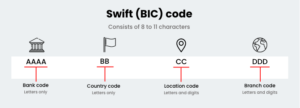In today’s interconnected world, businesses and individuals are increasingly conducting financial transactions across borders. Whether it’s making international payments, receiving funds from overseas, or conducting cross-border trade, these transactions require a secure way to transfer funds between banks and financial institutions in different countries.
We’ll explore what SWIFT codes are, how they work, how to find them, and why they are an essential part of the global financial system.
What are a SWIFT code and its uses?
A SWIFT code is a unique code that is used to identify a specific bank or financial institution in international transactions. The term “SWIFT” stands for Society for Worldwide Interbank Financial Telecommunication, which is the global network used by financial institutions to send and receive secure messages and financial transactions.
SWIFT codes consist of 8 or 11 characters and are used to identify the bank or financial institution in international money transfers, such as wire transfers and other types of international payments.
The first four characters represent the bank or institution code, the next two characters represent the country code, and the following two characters represent the location code. The last three characters, if present, are optional and represent the branch code.

The uses of SWIFT codes include:
Identifying banks and financial institutions

Identifying banks and financial institutions is one of the primary uses of SWIFT codes. Banks and financial institutions use SWIFT codes to uniquely identify themselves and to ensure that the funds are transferred to the correct recipient in international transactions.
International money transfers involve the exchange of funds between banks and financial institutions located in different countries. When initiating an international money transfer, the sender’s bank or financial institution will use the recipient’s bank’s SWIFT code to ensure that the funds are transferred to the correct bank or financial institution.
The SWIFT code allows the sending bank or financial institution to identify the recipient’s bank or financial institution with precision, ensuring that the funds are not mistakenly transferred to the wrong recipient.
Facilitating international money transfers
Facilitating international money transfers is another important use of SWIFT codes. When a person or organization wants to transfer funds internationally, their bank or financial institution will require the recipient’s bank or financial institution’s SWIFT code to initiate the transaction. The SWIFT code is used to uniquely identify the recipient’s bank or financial institution, ensuring that the funds are transferred to the correct account and institution.
Without SWIFT codes, it would be difficult and time-consuming to transfer funds across international borders. SWIFT codes help to simplify and streamline the transfer process, allowing for faster and more secure transfers.
Enhancing transaction security
SWIFT codes play a crucial role in enhancing the security of international transactions. When a person or organization initiates an international money transfer, the SWIFT code of the recipient’s bank or financial institution is used to identify and verify the institution. This helps to ensure that the funds are transferred to the correct institution and account, reducing the risk of fraud.
In addition to helping ensure that funds are transferred to the correct institution, SWIFT codes also support the use of secure messaging in international transactions. SWIFT’s messaging system is designed to be secure, reliable, and confidential, helping to protect sensitive financial information during the transfer process. SWIFT messages are encrypted and can only be read by authorized parties, further enhancing the security of international transactions.
Streamlining international trade
When businesses engage in cross-border trade, they often need to make payments to suppliers or receive payments from buyers in different countries. In these cases, SWIFT codes are used to facilitate the transfer of funds between the buyer’s and seller’s banks or financial institutions.
By using SWIFT codes to identify and verify the banks or financial institutions involved in the transaction, international trade can be conducted more efficiently and with less risk. For example, a company in one country can initiate a payment to a supplier in another country using the SWIFT code of the supplier’s bank to ensure that the funds are transferred to the correct account. This helps to reduce delays and errors in the payment process and can help to build trust between buyers and sellers in different countries.
How do I find my bank SWIFT code?

To find your bank’s SWIFT code, you can follow these steps:
Check your bank statements
Your bank’s SWIFT code should be listed on your bank statement. Look for a section that includes details of international transactions or payments.
Contact your bank
If you can’t find your bank’s SWIFT code on your statement, you can contact your bank’s customer service. They can provide you with the correct SWIFT code for your bank.
Use online search tools
There are many online search tools that allow you to find SWIFT codes for banks around the world. You can search by bank name or location. Some popular search tools include swift.com, bank-codes.com, and theswiftcodes.com.
Check the IBAN
The International Bank Account Number (IBAN) may also include the bank’s SWIFT code. The first eight characters of an IBAN usually indicate the country code and the bank code, which may include the SWIFT code.
Understand the SWIFT code format
The SWIFT code is a unique identifier for banks and financial institutions worldwide. It is usually 8 or 11 characters long and includes a combination of letters and numbers. The first four characters indicate the bank’s head office location, the next two characters identify the country code, and the last two characters identify the branch code.
Is a SWIFT code the same as a routing number?
No, a SWIFT code and a routing number are not the same. A SWIFT code is used for international transfers and identifies specific banks and financial institutions worldwide. On the other hand, a routing number is a nine-digit code used in the United States to identify the financial institution that is responsible for the transaction.
The routing number is used for local transactions within the United States, such as direct deposit, electronic funds transfers (EFT), and bill payments. In contrast, the SWIFT code is used for international transactions, such as international wire transfers, to identify the specific bank and financial institution involved in the transaction.
What are examples of SWIFT code?
Here are some examples of SWIFT codes for various banks:
- JP Morgan Chase Bank, New York, USA: CHASUS33
- Bank of America, San Francisco, USA: BOFAUS6S
- Deutsche Bank, Frankfurt, Germany: DEUTDEFF
- Barclays Bank, London, UK: BARCGB22
- BNP Paribas, Paris, France: BNPAFRPP
- Royal Bank of Canada, Toronto, Canada: ROYCCAT2
- Westpac Banking Corporation, Sydney, Australia: WPACAU2S
These are just a few examples of SWIFT codes for different banks around the world. It’s important to note that each bank has a unique SWIFT code, and you should always verify the correct SWIFT code with your bank before initiating any international transactions.
In conclusion, SWIFT codes are a critical component of the global financial system. They provide a standardized way to identify and verify banks and financial institutions involved in international transactions, enhancing security and streamlining the transfer of funds between different countries.
Whether you’re sending money to a friend overseas or conducting cross-border trade, understanding SWIFT codes and how they work can help you navigate the complex world of international finance with confidence.
Read more

